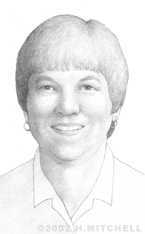Donna Shirley
Donna Shirley, the original leader of the team that built the Mars Pathfinder rover, grew up in Wynnewood, Oklahoma. As a teenager in the 1950s, she knew she wanted to become an engineer, despite the fact that few girls were entering the field at that time. Math was her worst subject, but she worked hard to learn it in pursuit of her dream.
At the young age of 16, Shirley earned her pilot’s license. In 1963, she received her BA in technical writing and BS in Aerospace Engineering from the University of Oklahoma. In 1968, she earned an MS in Aerospace Engineering from the University of Southern California. In 1966, she had begun working on the Mars Program at NASA’s Jet Propulsion Laboratory in Pasadena, California. She was an aerodynamicist assigned to solving the problem of how Mars landers could come through the atmosphere safely, without burning up or tumbling.
During more than 30 years at JPL, Shirley served in a variety of positions in engineering systems analysis for space missions. She worked on new space technologies with terrestrial applications, was the mission analyst for the Mariner Venus-Mercury mission in the early 1970s, and in the 1980s and 1990s she worked on the development of automation, robotics and mobile surface vehicles. Shirley is best known, however, as the first woman to head up a project for NASA, and for her work on the Sojourner rover, the first rover to explore the surface of Mars.
In 1979, Shirley headed a study of a Saturn orbiter and probe that led to Cassini, an international mission to Saturn that launched in October 1997. In the early 1990s, she was project engineer for the Cassini flight project. The spacecraft is expected to reach Saturn in 2004 and deploy a probe to Saturn's largest moon, Titan. In the 1980s, Shirley worked on an early version of NASA's space station and developed concepts for automated mobile vehicles to be used on planetary surfaces. She also led NASA teams developing systems engineering and management processes.
She was named manager of NASA’s Mars Exploration Program Office, when it was established in August 1994. She oversaw the development of the Mars Pathfinder’s rover, Sojourner, which successfully touched down on Mars on July 4, 1997. The event fulfilled a dream that many had considered impossible. Since then Shirley served as a spokesperson for the project, appearing on many local and international television and radio programs.
Shirley received numerous NASA group achievement awards, including a NASA Outstanding Leadership Medal. She was honored with the American Society of Mechanical Engineers Holley Award, and membership in the American Academy of Achievement, the Women In Technology International Hall of Fame, and the Oklahoma Aviation and Space Hall of Fame. Her autobiography, “Managing Martians: The Extraordinary Story of a Woman's Lifelong Quest to Get to Mars -- and of the Team Behind the Space Robot That Has Captured the Imagination of the World" was published in 1998. She also wrote the online book, "Managing Creativity: A Practical Guide to Inventing, Developing and Producing Innovative Products."
Shirley retired in 1998. She went on to serve as Assistant Dean of Engineering for Advanced Program Development at the University of Oklahoma, and was official spokesperson for the Mars Millennium Project, an international educational initiative sponsored by the White House Millennium Council, the Department of Education, the National Endowment for the Arts, the National Aeronautics and Space Administration, and the J. Paul Getty Trust.


